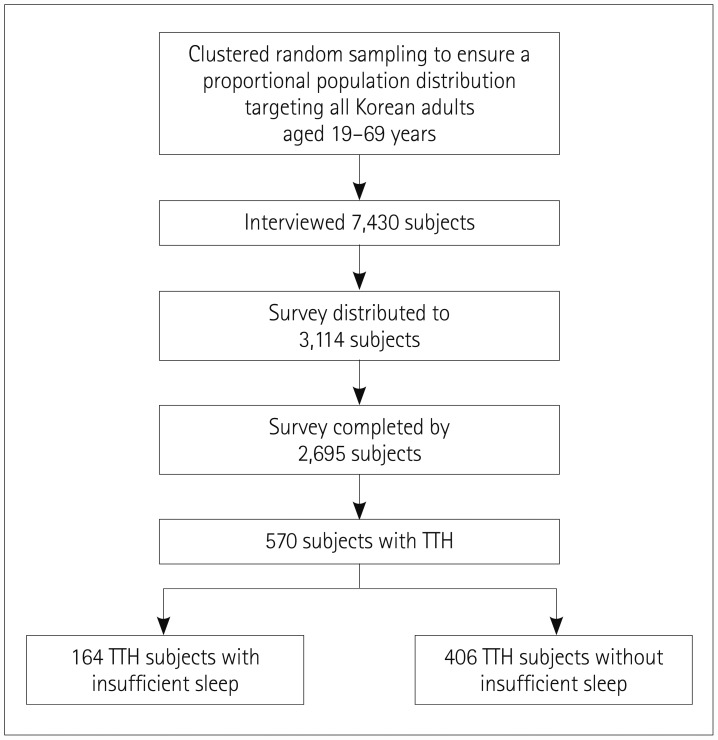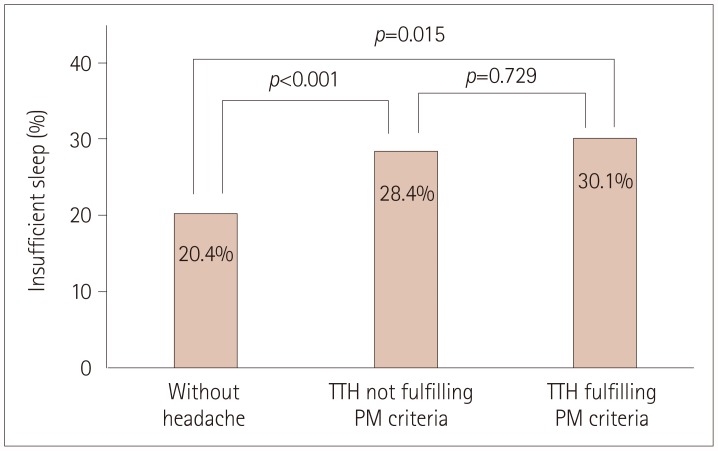J Clin Neurol.
2018 Oct;14(4):566-573. 10.3988/jcn.2018.14.4.566.
Insufficient Sleep in Tension-Type Headache: A Population Study
- Affiliations
-
- 1Department of Neurology, Jeju National University School of Medicine, Jeju, Korea.
- 2Department of Neurology, Dongtan Sacred Heart Hospital, Hallym University College of Medicine, Hwaseong, Korea.
- 3Department of Neurology, Gangnam Severance Hospital, Yonsei University, College of Medicine, Seoul, Korea.
- 4Sleep Disorders Center, Department of Neurology, Soonchunhyang University College of Medicine, Cheonan Hospital, Cheonan, Korea.
- 5Department of Neurology, Bundang Clinical Neuroscience Institute, Seoul National University Bundang Hospital, Seongnam, Korea.
- 6Department of Neurology, Severance Hospital, Yonsei University College of Medicine, Seoul, Korea. chumk@yonsei.ac.kr
- KMID: 2424187
- DOI: http://doi.org/10.3988/jcn.2018.14.4.566
Abstract
- BACKGROUND AND PURPOSE
Sufficient sleep is an essential part of good health and well-being. Tension-type headache (TTH) is the most common type of primary headache and has negative impacts on the quality of life and work performance. We aimed to determinethe relationship between TTH and insufficient sleep in the general population.
METHODS
This study used data from the Korean Headache Sleep Study, which was a population-based survey about headache and sleep among Korean adults. Insufficient sleep was defined when the discrepancy between sleep need and average sleep duration was at least 1 hour.
RESULTS
Among the 2,695 included subjects, 570 (21.2%) and 727 (27.0%) were classified as having TTH and insufficient sleep, respectively. The prevalence of insufficient sleep was significantly higher among subjects with TTH than among those without headaches (28.8% vs. 20.4%). For subjects with TTH, the scores on a visual analogue scale (4.7±1.8 vs. 4.3±1.9, mean±SD) and the Headache Impact Test-6 (44.9±7.0 vs. 43.6±6.1) were much higher in subjects with insufficient sleep than in those without insufficientsleep. Multivariable analyses revealed that insomnia [odds ratio (OR)=2.1], poor sleep quality (OR=1.7), and short sleep duration (OR=6.9) were significantly associated with insufficient sleep in subjects with TTH.
CONCLUSIONS
Our findings suggest that insufficient sleep is prevalent among subjects with TTH and is linked to an exacerbation of TTH. Therefore, the proper evaluation and management of sleep may lead to the better management of TTH.
Keyword
MeSH Terms
Figure
Reference
-
1. Stovner L, Hagen K, Jensen R, Katsarava Z, Lipton R, Scher A, et al. The global burden of headache: a documentation of headache prevalence and disability worldwide. Cephalalgia. 2007; 27:193–210. PMID: 17381554.
Article2. Rains JC, Davis RE, Smitherman TA. Tension-type headache and sleep. Curr Neurol Neurosci Rep. 2015; 15:520. PMID: 25475495.
Article3. Holt JB, Zhang X, Sizov N, Croft JB. Airport noise and self-reported sleep insufficiency, United States, 2008 and 2009. Prev Chronic Dis. 2015; 12:E49. PMID: 25880768.
Article4. Strine TW, Chapman DP. Associations of frequent sleep insufficiency with health-related quality of life and health behaviors. Sleep Med. 2005; 6:23–27. PMID: 15680291.
Article5. Maia Q, Grandner MA, Findley J, Gurubhagavatula I. Short and long sleep duration and risk of drowsy driving and the role of subjective sleep insufficiency. Accid Anal Prev. 2013; 59:618–622. PMID: 23973762.
Article6. Altman NG, Izci-Balserak B, Schopfer E, Jackson N, Rattanaumpawan P, Gehrman PR, et al. Sleep duration versus sleep insufficiency as predictors of cardiometabolic health outcomes. Sleep Med. 2012; 13:1261–1270. PMID: 23141932.
Article7. Hublin C, Kaprio J, Partinen M, Koskenvuo M. Insufficient sleep--a population-based study in adults. Sleep. 2001; 24:392–400. PMID: 11403523.
Article8. Kim J, Cho SJ, Kim WJ, Yang KI, Yun CH, Chu MK. Insomnia in tension-type headache: a population-based study. J Headache Pain. 2017; 18:95. PMID: 28900887.
Article9. Odegård SS, Sand T, Engstrøm M, Stovner LJ, Zwart JA, Hagen K. The long-term effect of insomnia on primary headaches: a prospective population-based cohort study (HUNT-2 and HUNT-3). Headache. 2011; 51:570–580. PMID: 21457241.10. Chung PW, Cho SJ, Kim WJ, Yang KI, Yun CH, Chu MK. Restless legs syndrome and tension-type headache: a population-based study. J Headache Pain. 2017; 18:47. PMID: 28424977.
Article11. Kristoffersen ES, Stavem K, Lundqvist C, Russell MB. Excessive daytime sleepiness in chronic migraine and chronic tension-type headache from the general population. Cephalalgia. 2018; 38:993–997. PMID: 28691516.
Article12. Cho SJ, Chung YK, Kim JM, Chu MK. Migraine and restless legs syndrome are associated in adults under age fifty but not in adults over fifty: a population-based study. J Headache Pain. 2015; 16:75.
Article13. Headache Classification Committee of the International Headache Society (IHS). The International Classification of Headache Disorders, 3rd edition (beta version). Cephalalgia. 2013; 33:629–808. PMID: 23771276.14. Kim BK, Chu MK, Lee TG, Kim JM, Chung CS, Lee KS. Prevalence and impact of migraine and tension-type headache in Korea. J Clin Neurol. 2012; 8:204–211. PMID: 23091530.
Article15. Bastien CH, Vallières A, Morin CM. Validation of the Insomnia Severity Index as an outcome measure for insomnia research. Sleep Med. 2001; 2:297–307. PMID: 11438246.
Article16. Morin CM, Belleville G, Bélanger L, Ivers H. The Insomnia Severity Index: psychometric indicators to detect insomnia cases and evaluate treatment response. Sleep. 2011; 34:601–608. PMID: 21532953.
Article17. Kim J, Cho SJ, Kim WJ, Yang KI, Yun CH, Chu MK. Insomnia in probable migraine: a population-based study. J Headache Pain. 2016; 17:92. PMID: 27709437.
Article18. Netzer NC, Stoohs RA, Netzer CM, Clark K, Strohl KP. Using the Berlin Questionnaire to identify patients at risk for the sleep apnea syndrome. Ann Intern Med. 1999; 131:485–491. PMID: 10507956.
Article19. Kwon C, Shin SY, Lee KH, Cho JS, Kim SW. Usefulness of Berlin and STOP questionnaires as a screening test for sleep apnea in Korea. Korean J Otorhinolaryngol-Head Neck Surg. 2010; 53:768–772.
Article20. Goldberg D, Bridges K, Duncan-Jones P, Grayson D. Detecting anxiety and depression in general medical settings. BMJ. 1988; 297:897–899. PMID: 3140969.
Article21. Lim JY, Lee SH, Cha YS, Park HS, Sunwoo S. Reliability and validity of anxiety screening scale. J Korean Acad Fam Med. 2001; 22:1224–1232.22. Pignone MP, Gaynes BN, Rushton JL, Burchell CM, Orleans CT, Mulrow CD, et al. Screening for depression in adults: a summary of the evidence for the U.S. Preventive Services Task Force. Ann Intern Med. 2002; 136:765–776. PMID: 12020146.
Article23. Choi HS, Choi JH, Park KH, Joo KJ, Ga H, Ko HJ, et al. Standardization of the Korean version of Patient Health Questionnaire-9 as a screening instrument for major depressive disorder. J Korean Acad Fam Med. 2007; 28:114–119.24. Song TJ, Yun CH, Cho SJ, Kim WJ, Yang KI, Chu MK. Short sleep duration and poor sleep quality among migraineurs: a population-based study. Cephalalgia. 2018; 38:855–864. PMID: 28641451.
Article25. Kim J, Cho SJ, Kim WJ, Yang KI, Yun CH, Chu MK. Insufficient sleep is prevalent among migraineurs: a population-based study. J Headache Pain. 2017; 18:50. PMID: 28455722.
Article26. Andrews JG, Oei TP. The roles of depression and anxiety in the understanding and treatment of Obstructive Sleep Apnea Syndrome. Clin Psychol Rev. 2004; 24:1031–1049. PMID: 15533283.
Article27. Calhoun SL, Vgontzas AN, Fernandez-Mendoza J, Mayes SD, Tsaoussoglou M, Basta M, et al. Prevalence and risk factors of excessive daytime sleepiness in a community sample of young children: the role of obesity, asthma, anxiety/depression, and sleep. Sleep. 2011; 34:503–507. PMID: 21461329.
Article28. Chen PJ, Huang CL, Weng SF, Wu MP, Ho CH, Wang JJ, et al. Relapse insomnia increases greater risk of anxiety and depression: evidence from a population-based 4-year cohort study. Sleep Med. 2017; 38:122–129. PMID: 29031746.
Article29. Klumpp H, Roberts J, Kapella MC, Kennedy AE, Kumar A, Phan KL. Subjective and objective sleep quality modulate emotion regulatory brain function in anxiety and depression. Depress Anxiety. 2017; 34:651–660. PMID: 28419607.
Article30. Sevim S, Dogu O, Kaleagasi H, Aral M, Metin O, Camdeviren H. Correlation of anxiety and depression symptoms in patients with restless legs syndrome: a population based survey. J Neurol Neurosurg Psychiatry. 2004; 75:226–230. PMID: 14742594.31. Wang Y, Xie J, Yang F, Wu S, Wang H, Zhang X, et al. Comorbidity of poor sleep and primary headaches among nursing staff in north China. J Headache Pain. 2015; 16:88. PMID: 26449228.
Article32. Cho YW, Song ML, Morin CM. Validation of a Korean version of the insomnia severity index. J Clin Neurol. 2014; 10:210–215. PMID: 25045373.
Article33. Sohn SI, Kim DH, Lee MY, Cho YW. The reliability and validity of the Korean version of the Pittsburgh Sleep Quality Index. Sleep Breath. 2012; 16:803–812. PMID: 21901299.
Article34. Hinz A, Glaesmer H, Brähler E, Löffler M, Engel C, Enzenbach C, et al. Sleep quality in the general population: psychometric properties of the Pittsburgh Sleep Quality Index, derived from a German community sample of 9284 people. Sleep Med. 2017; 30:57–63. PMID: 28215264.
Article35. Peng KP, Wang SJ. Epidemiology of headache disorders in the Asiapacific region. Headache. 2014; 54:610–618. PMID: 24666014.
Article36. Yoon IY, Kripke DF, Youngstedt SD, Elliott JA. Actigraphy suggests age-related differences in napping and nocturnal sleep. J Sleep Res. 2003; 12:87–93. PMID: 12753345.
Article



